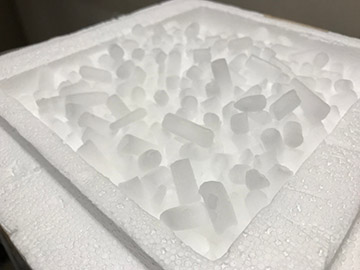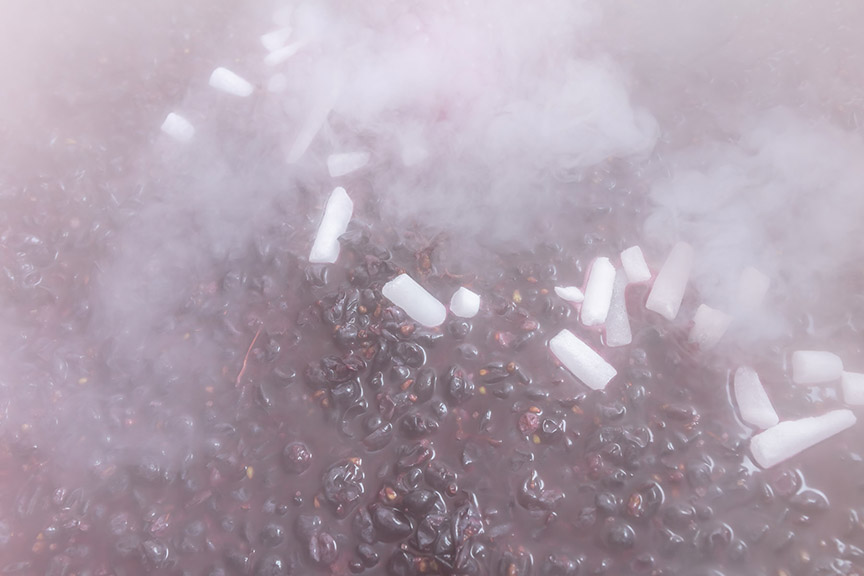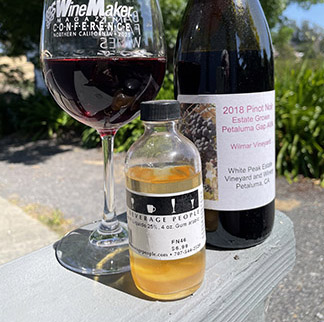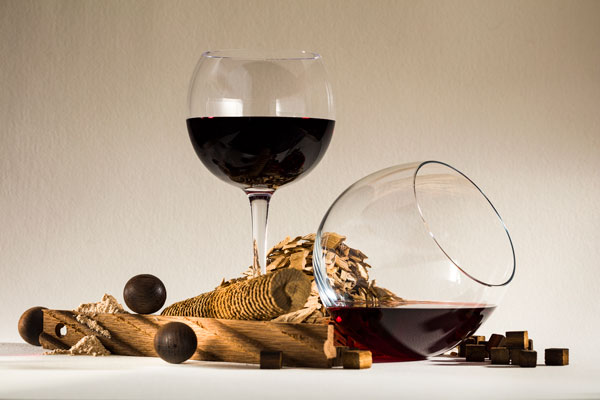Using Dry Ice

You may find yourself a bit surprised at the wide range of applications for dry ice in home winemaking. Diverse as they are, the uses arise from two fundamental properties of dry ice: It is 100 percent carbon dioxide and it is very cold. Those same properties also make up the principal hazards of using dry ice and dictate careful safety procedures for winemakers who employ it.
At standard atmospheric pressure (1 atm or 1.013 bar) carbon dioxide does not exist in a liquid form regardless of temperature. Many familiar substances like water pass through three different phases while warming from the solid state. Ice melts to become liquid water; liquid water boils to become steam or water vapor. Solid carbon dioxide, though, warms from dry ice to evaporate (or, more correctly, sublimate) directly to CO2 gas. While you can purchase and use a compressed gas cylinder of liquid carbon dioxide, it exists in that state because of the elevated pressure in the tank. The ready availability of dry ice today is a fairly modern phenomenon. First described by French scientist Adrien-Jean-Pierre Thilorier in the nineteenth century, dry ice did not become commercially available until the 1920s. It is now commonly sold by welding gas retailers, ice companies, and sometimes ice cream shops and supermarkets. While blocks of dry ice are popular for keeping foods frozen while shipping, home winemakers more often use pellets that are about half an inch (1 cm) in diameter and an inch or two (2.5–5 cm) in length, or smaller pellets more like the size of rice or peas.
Ordinary water ice melts (or freezes) on either side of 32 °F (0 °C). If you keep a bag of ice in a chest freezer, it will cool to the temperature of other frozen items in that freezer — perhaps 0 °F (-18 °C). When taken out of the freezer to keep something else cold, the ice absorbs a relatively small amount of heat on warming as a solid from the freezer temperature to the melting point. By contrast, it absorbs a much larger amount of heat as it changes from the solid phase to the liquid phase.
At a given atmospheric pressure, the amount of heat absorbed by a particular mass of ice (or any solid when melting) is a fixed characteristic of the material. That thermodynamic variable is called enthalpy or heat of fusion. I describe it here to help compare conventional ice vs. dry ice for cooling. The conversion of 1 kg of ice to water at 32 °F (0 °C) absorbs 334 KJ (or kilojoule) of heat. KJ is a unit of energy commonly used in physics and engineering. Compare the value to the commonly used energy unit for food, the calorie (or kcal), which is equivalent to 4.18 KJ. Dry ice, at its sublimation temperature of -109 °F (-78.5 °C), absorbs 571 KJ/kg as it sublimates. A kilogram of dry ice not only starts much colder than a kilogram of water ice, it also absorbs 1.7 times as much heat in making the phase transition. Everything else held equal, you get more cooling effect per pound of dry ice than per pound of water ice.
Efficiency isn’t the only benefit of dry ice vs. ice, of course. If you were to put ice in your wine or must, the resulting melt water would dilute your fermentation. When dry ice sublimes, the carbon dioxide gas that it becomes instead evaporates off, although some is left behind as dissolved carbon dioxide or carbonic acid. The combination of effective absorption of heat and self-removing residue combine to favor dry ice over water ice for cooling in many winemaking applications.
In other applications, the production of carbon dioxide gas is the desired outcome, rather than just a convenient byproduct. One kilogram of dry ice produces about 500 L of carbon dioxide gas at atmospheric pressure. Using dry ice for carbon dioxide gas production has some advantages over liquefied CO2 in a cylinder. As with any compressed gas cylinder, carbon dioxide requires a specific regulator equipped with one or more pressure gauges and various hoses and valves. Aside from insulation such as a cooler to minimize losses during transportation, dry ice requires no special equipment.
Before we get into the many uses for dry ice in the winemaking process, we need to discuss safety. This is very important! Carbon dioxide is an asphyxiating gas and dry ice is very, very cold. Bare skin in direct contact with dry ice can quickly suffer frostbite, so one must wear heavy gloves when handling. If using dry ice to cool grapes while you take them home, do not carry them inside a closed vehicle where gas can build up. Similarly, when using dry ice for cellar purposes, make sure the space is continuously well ventilated. Unlike carbon monoxide detectors, carbon dioxide detectors are typically cost-prohibitive. So it’s best to just leave any doors to the area open, turn on nearby exhaust fans or portable fans to exhaust and circulate air and, if needed, open windows.
Dry Ice Applications
Transportation
One application for dry ice that I often see is for cooling and transportation of grapes at harvest. Common advice is to pick grapes either at night or very early in the morning while they are cool and transport them as quickly as possible. Unfortunately, these conditions are not always under the control of the home winemaker. And even when they are, if the ride home with grapes in tow is hours long, you may need additional measures to keep the grapes cool. Dry ice is very useful in these scenarios. Before heading to the vineyard to pick up purchased grapes, the winemaker can buy 10–20 lbs. (~5–10 kg) of dry ice pellets at the local welding gas supply and carry them along in a hard-side cooler chest. For safety, the chest needs to allow gas venting and should be kept in the bed of the pickup to avoid
a buildup of CO2 gas in the passenger cab (or ride with the windows open). Once the grape bins are loaded aboard, a layer of dry ice pellets is scattered directly on the fruit to begin cooling it. Covering the bins with a tarp or a plastic lid will provide some insulation and has the advantage of minimizing further oxidation risk as a blanket of inert carbon dioxide develops from the sublimation of the dry ice. WineMaker’s “Wine Wizard” columnist Alison Crowe notes that she likes to float a pie tin of dry ice pellets on top of the must in a half-ton bin to help maintain that inert atmosphere.
Cold soak
A related use for dry ice in the home winery is establishing a cold soak for the must. It is helpful to place some of the dry ice pellets in the fermenter before adding the crushed and destemmed fruit. Cryonomic, a Belgian manufacturer of dry ice production machinery, estimates that about 1.3 kg of dry ice will lower the temperature of 100 kg of grapes by 1 °C (2.9 lbs. of dry ice for 220 lbs. of grapes for a 1.8 °F decrease). If your harvest comes in hot and you want to cold soak for a few days, you will need a large amount of dry ice. Correspondingly, a great deal of carbon dioxide gas will be released. Therefore, using dry ice to establish a cold soak may not be the most efficient way to lower the temperature. Though if the grapes are already cool and the must is being stored in a cool place dry ice can help keep your the must temperature a few degrees cooler without using a tremendous amount.
Fermentation

Where dry ice is often better used is in keeping a fermentation steadily cool – another common process in winemaking, especially when making white wine. Various methods are available, such as recirculating glycol chillers, an air-conditioned cellar, or adding sealed jugs of frozen water (to get the cooling, but avoid the dilution). To use dry ice for temperature management during fermentation, Cryonomic estimates that you need 0.6 kg of dry ice in one hL of must to lower the temperature by 1 °C (1.3 lbs. to cool 26 gallons by 1.8 °F). If you keep a chest of dry ice pellets on-hand to use like this, keep in mind that you will be continuously losing some of its weight while releasing carbon dioxide into the space where the chest is stored. Heavy insulation or even keeping the chest inside a freezer will help slow the loss of the remaining pellets.
Carbonic maceration
If you wish to make a nouveau-style red wine using carbonic maceration, dry ice can help with that. Carbonic maceration is carried out in a closed tank (fitted with a fermentation lock or breather bung). About 10% of the must is usually crushed and placed in the bottom of the tank and then whole clusters are loaded in to the remaining space. The lid is fitted, and the tank is purged with carbon dioxide. The grapes are then left to macerate for a week or so before being removed, pressed, and finished conventionally. If you do not have a compressed gas system for purging the tank, you can place a few scoops of dry ice pellets in the bottom of the tank before loading in the grapes to achieve the same effect.
Air displacement
The gas purging effect can be used in other ways around your winery as well. Before racking wine into a tank, you can allow dry ice pellets to sublimate off in the bottom to displace air and leave an inert atmosphere. If you do this for a glass carboy, take care that the dry ice does not fall directly on the bottom and crack it from thermal shock. For stainless steel or plastic containers, there will be much less risk of harm to the vessel — but do make provisions for the gas to escape without building up pressure.
Sparkling wine production
In considering pressure buildup, we reach the final application I want to consider. Sparkling wine can be carbonated by natural fermentation in the bottle by the traditional method or by petillant naturel, by captured bulk gas production in the Charmat process, or force carbonated with compressed gas from a cylinder. One additional option is to use dry ice. Still wine, confined to a heavy pressure-capable sparkling wine bottle, can be carbonated by adding a small amount of dry ice and sealing the bottle with a crown cap or Champagne cork. The amount of headspace will make a difference in the exact mass required. Calculated on a concentration basis, the U.S. legal definition of “sparkling wine” (for tax rate purposes) is wine that contains at least 3.92 g of carbon dioxide per liter of wine. That produces a pressure of about 1 atm in excess of ambient pressure. Most Champagne-style wines instead carry up to about 6 atm of pressure. I have not tried this method of carbonating wine, but recommendations I have seen advise using about 4 to 7 g of dry ice added to each 750 mL bottle of wine. Chill the bottle, wear gloves, and handle with care.
Considering this process further, here are some thoughts so as to not make a complete mess:
• Fining/filtering and degassing the wine beforehand is advisable to avoid surprises with the wine foaming over (the pellets are a nucleating agent).
• Fill the bottle halfway first, then insert the pellets, and then carefully top up the bottle before corking/capping. (i.e., add the pellets to the wine rather than adding wine to the pellets — small quantities of liquids added to the dry ice will make a gooey sludge as the water freezes and the dissolved solids will precipitate/congeal).
Make Your Own Dry Ice
If you plan to use dry ice often, you may want to look into making your own dry ice.
Laboratory-scale dry ice makers cost between $400 and $2,000. You connect the device to a liquefied carbon dioxide cylinder that is equipped with a dip tube so it delivers liquid CO2 from the bottom of the cylinder rather than the usual gas from the headspace. Evaporation of the liquid carbon dioxide causes rapid cooling, leaving some of it in the ice maker’s reservoir as dry ice flakes or blocks. In the analytical chemistry years of my working career, I used one of these devices and it is very convenient. Losses are high, though. One such system listed by lab supplier Cole-Parmer produces a 1-kg (2.2-lb.) block in under two minutes. From a 75-lb. (34-kg) CO2 cylinder it will make 5 or 6 of those blocks, or up to 13 lbs. (6 kg). From your 75 lbs. (34 kg) of liquid carbon dioxide, you derive up to 13 lbs. (6 kg) of solid dry ice, or a yield of about 17%.





